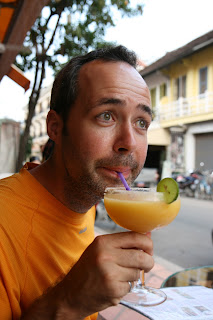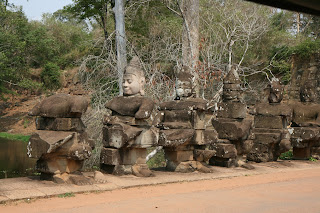 |
| Hello, fancy bus with snacks, intermittent wifi, and good A/C. |
 |
| Seeking out the shade at a rest stop along the way. |
The bus was a great way to see some Cambodian countryside - lots of rice fields, houses on stilts, and garbage remnants (exclusively tons and tons of plastic bags and bottles strewn all along the roadside). [Note from Chad: given the poorness of the country, it's not surprising that perfect litter pickup is not achieved.] Arriving in Siem Reap we set ourselves up at our lovely hotel and headed to check out the town. It is full to the brim with tourists, and apparently has been built up a lot over the last five years in particular as the gateway to Angkor Wat. Lots of good restaurants to choose from and places to spend your shopping dollars. [Note from Chad: But inexpensive and lacking the usual "tourist trap resort" feel, thankfully.]
We found a Mexican place recommended by Grace and Luke with food to rival any Mexican I've ever had before (and I've tried out a lot). [Note from Chad: I think Sarah was just happy to have food that was safe for her to eat.]
 |
| Yes, this is a delicious mango margarita. |
 |
| I am just as thrilled with my fresh watermelon juice. |
After dark, downtown turns into one giant night market with lots of lovely lights.
And the next day it was time for the serious business of temple visiting. We went all out and hired a guide for Angkor Wat as well as a tuk-tuk to drive us around for the day. Totally worth every penny. The heat was insufferable for biking, and our guide was awesome (all official guides are university-trained and government-sanctioned) - he knew his stuff, told me all the best places to take photos, and arranged our tour so we saved the shady part for the hottest part of the day.
The Temples of Angkor are Cambodia's pride and joy (Angkor Wat is on their national flag), and for good reason. Angkor Wat itself is the largest temple - and the world's largest religious building - but there are 90 other temples scattered around this area and 400 in the province. The Siem Reap temple area was a city that, at its height around 1000-1200 AD, had a population of one million people (possibly the largest in the world).
[Note from Chad: according to our guide, at the height of the empire the Angkor kings would build three temples during their lifetime. The reach of the empire was vast, and building the temples was a great honour, so no slave labour was used. The amount of engineering and artistic skill that went into these temples meant a huge number of professional-level people had to be employed - especially since the window of time to build each temple was fixed and finite before work began, and they had to be completed within the king's lifetime. For example, legend has it that Angkor Wat (including all buildings, wall and moat) was completed in as little as 9 years, though some say it might have been more like 32 years. Anything less than 100 years is unbelieveable - consider that European cathedrals took several centuries to complete. Each new king felt that to hold the people in awe (and keep control), he needed to build a bigger temple than the last king - hence the huge number of big temples in the area. Most of the temples contain Hindu art, though many contain Buddhist themes (or a combination), depending on the religion of the king at the time. And most of the more popular temples have seen significant restoration efforts, so they're in much more "original" condition now than, say, 100 years ago. This is fine, except for those temples that look exotic due to their ruinous nature (like the "Lara Croft - Tomb Raider" temple) and which are in the middle of being made unfortunately "nice".]
Angkor Wat is surrounded by a moat that is a giant rectangle - 1.5 km by 1.3 km, and 190 metres wide. Keep in mind, this was all dug by hand and/or elephant.
Our first glimpse of the eastern (minor) gate - a bit crumbling but even the gates are impressive with clean, straight lines and ornate carvings.
And through the gate is the granddaddy of all temples - Angkor Wat. Not to rave, but it is breathtaking. It was built from 1113-52 by King Suryavagman II, who was different from earlier kings because of his devotion to the Hindu deity Vishnu. Angkor Wat has been in virtually continuous use since it was built.
 |
| See the big colonnades? Their inside walls are covered with bas-relief carvings. |
 |
| Even monks gawk at Angkor Wat! (And they take iPhone photos) |
 |
| Reflected in the ladies' bathing pool as we walked away. Not that I'd be doing any bathing in that pool! |
Angkor Wat housed about 2000 monks and 2000 dancers back in the day. Dancers were very important, chosen very young and trained continuously to represent godly perfection. Monks could have families, but dancers could not, and the two groups kept separate.
 |
| My first elephant sighting ever! |
Our next stop was the also-lovely Angkor Thom; less renown but far larger than Ankgor Wat. Angkor Thom is famous for its bas-relief of the Churning of the Ocean of Milk, in which 54 gods and 54 demons are engaged in a tug of war, on its entrance gate structure. This relief has been carefully restored and is very impressive. And it is not the only one!
 |
| The Churning of the Ocean of Milk. |
 |
| This relief stretches as far as the eye can see. |
Inside of Angkor Thom is the Bayon, which is a temple built by King Jayavarman VII. It has 54 gothic towers decorated with 216 enormous stone faces. The Lonely Planet says the faces "smile coldly" and "glare down" on you, but our guide thought they were happy faces. Photos don't do it justice - it's amazing.
 |
| The Bayon has 1.2 km of bas-reliefs which portray scenes of daily life and incorporate more than 11,000 figures! |
 |
| See the faces? |
 |
| Our awesome guide, Mr. Pissa. |
 |
| Chad climbed up to get some better views - I stayed at the bottom, not keen on a staircase sloped at up to 80 degrees! |
Next was the Victory Gate - Pisa's favourite, and pretty damn cool.
 |
| Note the elephant carvings |
Our team outside our much-needed lunch stop.
This is a gigantic swimming pool that apparently isn't very good for swimming. But it was genuinely dug 1000 years ago, primarily for bathing. I'm sure millions could bath in it at once.
Our last stop of the day was Ta Prohm, which was built in 1186 and has been mostly taken over by the jungle since then. Scenes from the movie Tomb Raider were filmed here.
 |
| Cool un-restored rubble on the left, reconstructed temple on the right |
 |
| This before and after shot was useful for demonstrating how much reconstruction really has been done in some parts. |
Colour me cynical, but I did not expect to be impressed by Angkor Wat (or Cambodia for that matter). But the temples of Angkor truly blew me away - they really are one of the wonders of the world. And we found Cambodia - at least the already-touristed parts that we visited - to be accessible and full of friendly people eager to help us out. Overall, a highlight of our trip!
































No comments:
Post a Comment